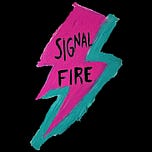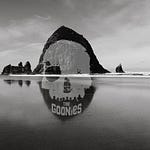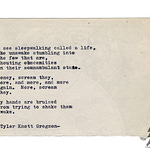Today, my lovely friends, is Easter Sunday, and if you’re someone who celebrates it, I’m here to wish you the very happiest of Easters. Happy Easter. Today, instead of getting into the nuts and bolts of what Easter is to the Christian community, we’re gonna get a little bit nerdy, a little bit time-travellery, and go back to the root of it all. We’re gonna discover a bit about where Easter came from, what it meant then, what it can mean now, and throw out some weird and hopefully interesting facts about the holiday you may not have known before today, and then, we’re gonna try to wrap it all up in a happy little Eastery bow with a lesson I take on the whole shebang. Is shebang actually a word? It didn’t spellcheck red dotted underline me, so I’m gonna say it is, which is fantastic. At any rate, let’s get into it, and once again, Happy Easter!
First, foremost, most confusingly if we start at now and work our way backwards, is this simple fact about Easter: The date of Easter, the day the resurrection of Jesus Christ was said to take place, actually changes from year to year. Why, you may ask yourself? Why would a day that is rooted in a historical event shift? Why would we celebrate it on different days, instead of just the day it happened, like a birthday? We won’t go into the Christmas and Jesus birthday thing here, that’s a different post for a different day, but nevertheless, that’s a fair question to be asking. Turns out, there is an answer, and I have it for you today, so you don’t have to go looking. Easter, the day we celebrate, is actually directly rooted to something much older than Jesus and his resurrection, and much more pagan. Easter is the first Sunday after the first full moon that follows the Spring Equinox. Oof that’s a mouthful. Easter, plain and simple, is a rite of Spring, always was, and always will be, and like most other holidays we celebrate to this day, its modern incarnation is a blending, a hodgepodge of both Christian and Pagan beliefs, rituals, and yes, festivities.
Just like Christmas was created and followed the Winter Solstice on the calendar the Romans cooked up to represent the light that Christianity was going to be bringing to the darkness — ok I lied, I did talk about Christmas and how most scholars agree ol’ JC wasn’t born on December 25th at all — Easter was created in a similar metaphorical sense. Simply put, Spring is an end to the cold and the dark, the return of life to the land. What better time to associate the aforementioned resurrection? But, but you may be raising your hand and holding your arm up with your other arm from behind your head and neck like we did in elementary school (tell me you didn’t just do that and laugh?), why is it called Easter then?! Where did that name come from, why don’t we call it Resurrection Day or something? Ahh my friends, I’ve got you again, worry not. Turns out, the Pagans that gave us this rite of Springtime celebration had a goddess all their own that was the goddess of this precise time of year. Her name, as shocking as it may be, was Eostre. A monk of yore mentioned in some ancient texts how the local non-Christians were celebrating around this time of year, he mentioned the name, and dammit, the name stuck. Now, an interesting (to me) aside is this: Not everyone calls it Easter. In the Jewish faith, and in many other countries, the holiday more closely translates to “The Passover.” Whatever the case, whatever it was called, in English speaking places, after some serious Councils, we landed where we landed and Easter stuck to a Sunday, always a Sunday and kept its name.
Now, you may be even more perplexed after hearing all this, as the unofficially official symbols of Easter we know and see everywhere today have nothing to do with Jesus, with Christianity at all, but around a bunny, and some eggs, and some baskets, and some chocolate wrapped in foil, and some pastel colors. Turns out, as Easter had always been, at its origins, about Springtime, painted and decorated eggs have been around since at least the medieval times, and the emergence of the “Easter Hare” popped out sometime in the 17th century, as a new focus on childhood and innocence was rising to the surface, a little wild Easter hare to bring eggs to good children. Fast forward in your time traveling, and that wild hare became a domestic (sometimes talking and walking and scaring the living shit out of kids in malls across the world) bunny. Once again, it stuck.
Whatever the case, whatever you know or think about this holiday, it’s amazing to look around and see just how completely rooted in Springtime, in paganism, it truly is. It absolutely is a rite of Spring, it absolutely is about rebirth, about beginning again, about rising from the darkness and finding the light and joy again. And you know what, what a beautiful thing?
I think of Easter as Eostre, as rebirth, as eggs steaming in still chilled air. I think of Easter as a halfway point of sorts between the darkness of Winter Solstice, and the Light of Summer Solstice. A balance between the two, between these two worlds that hold such beautiful and equal value. I think of it as a time to begin again, to rise like grass from snow, like bird from nest, like bunny from hollow. We must allow ourselves to begin again, to resurrect from the cold, we must allow ourselves to reach for the light while the dark is still right behind us, whispering doubt and chill. We must start fresh. We must.
Happy Easter friends, tell me how you’re beginning again?
Call this a rebirth,
raising pieces of yourself
long since forgotten.














